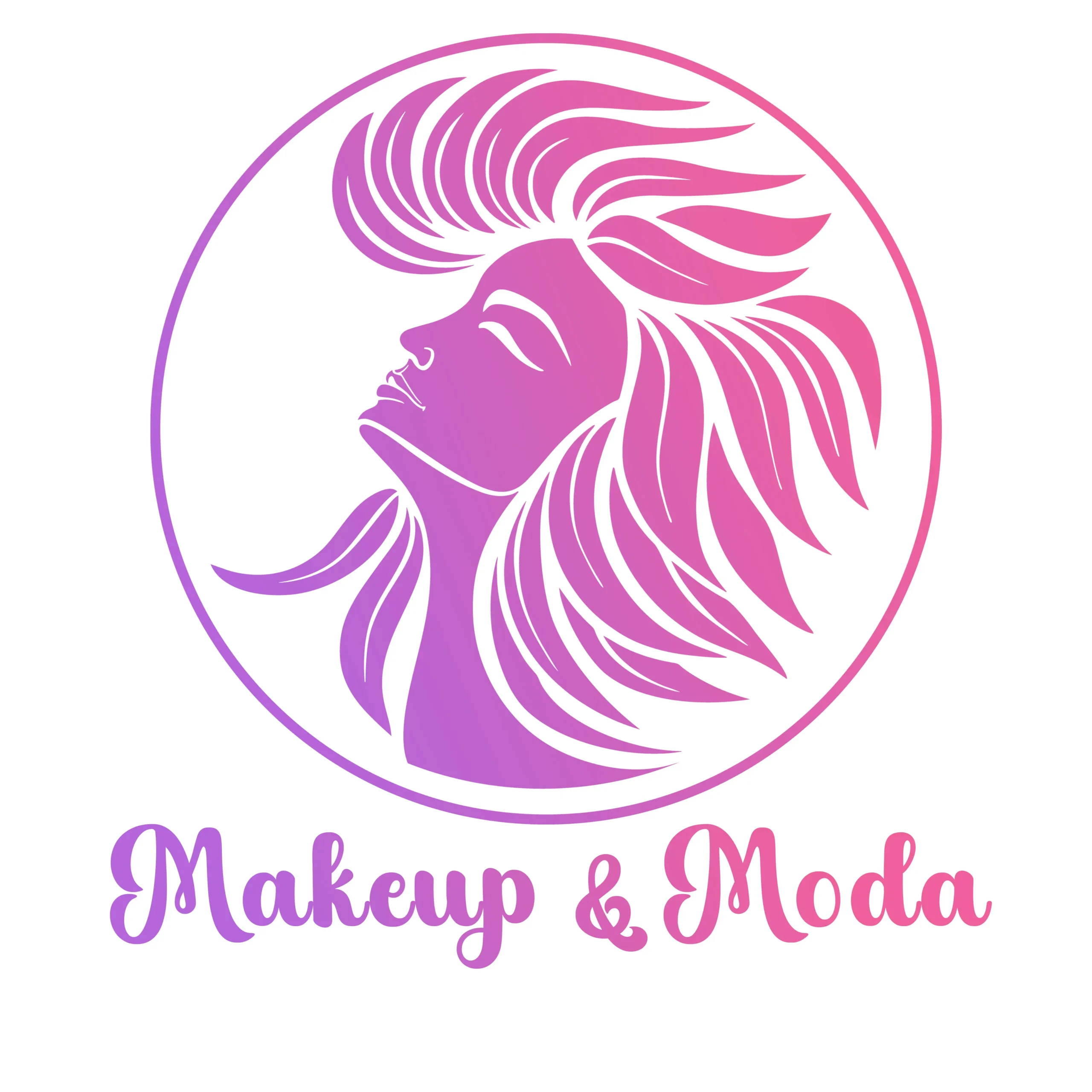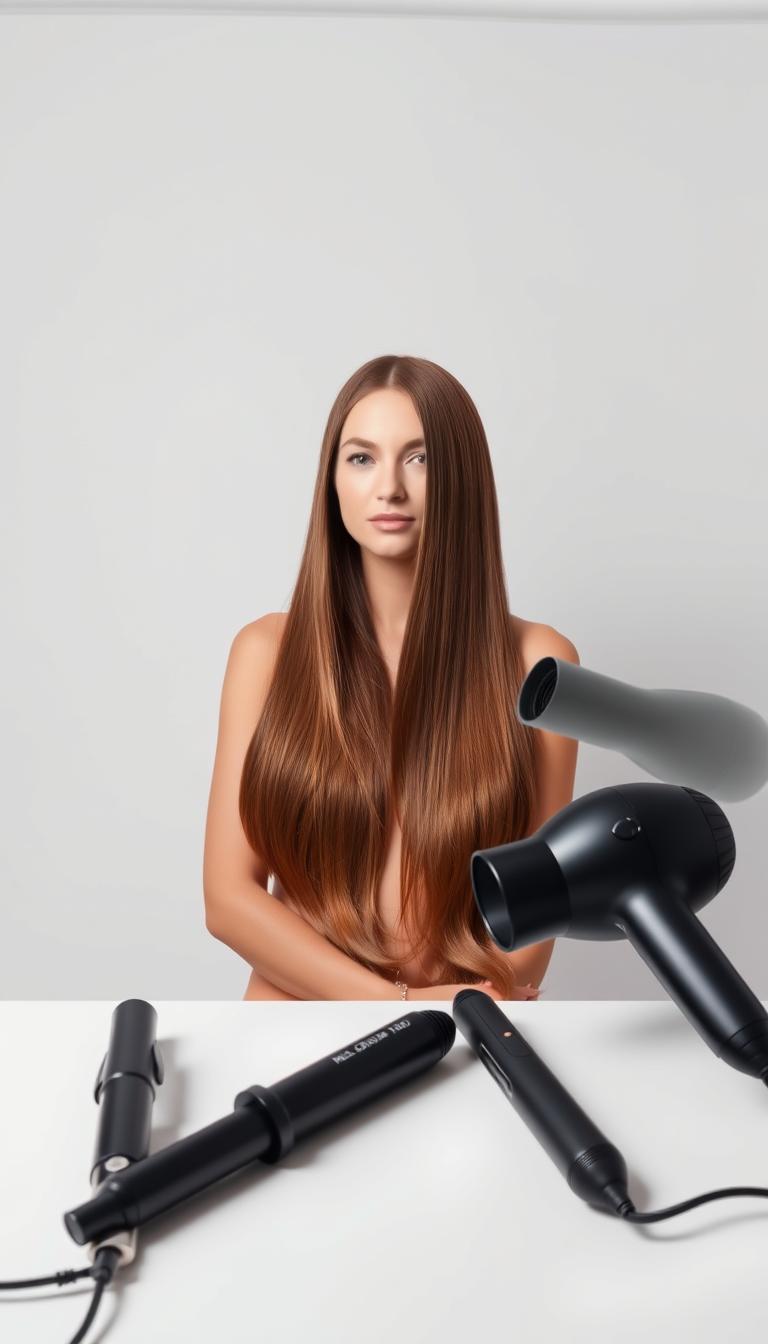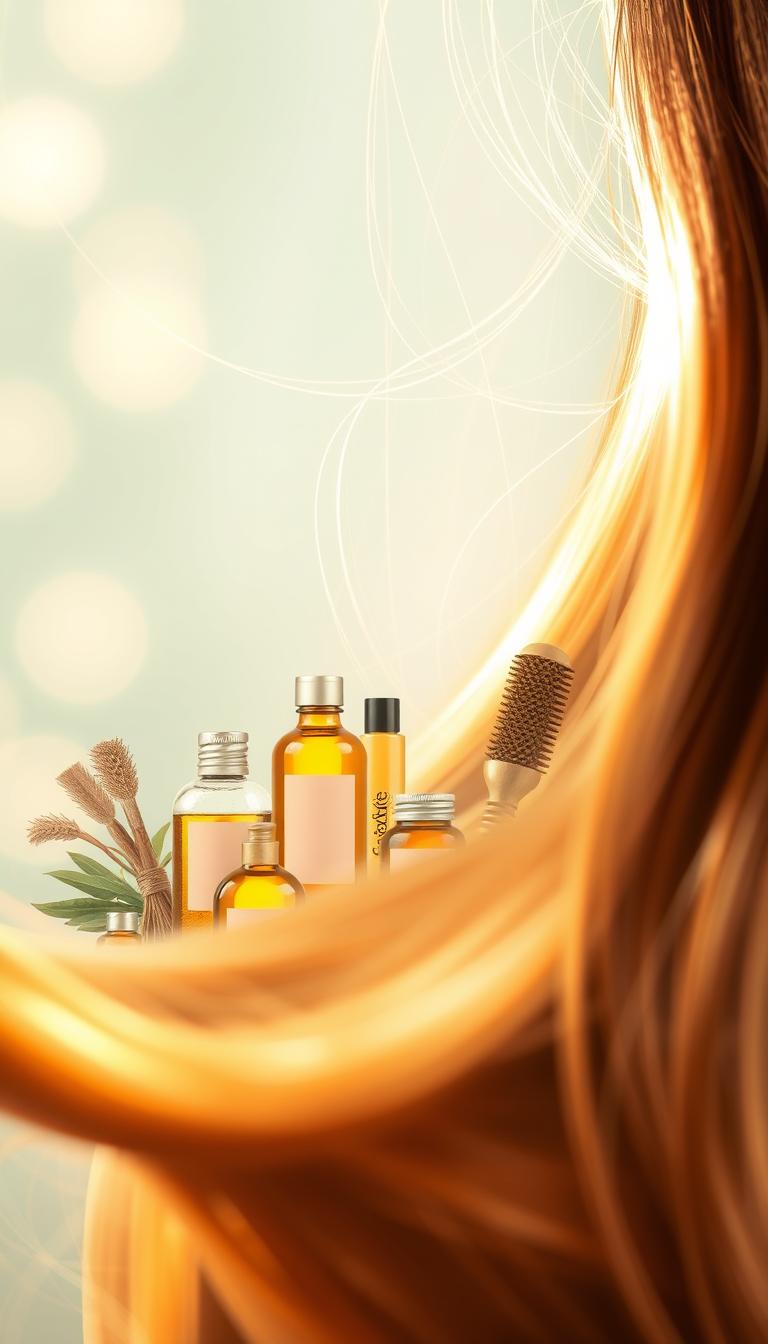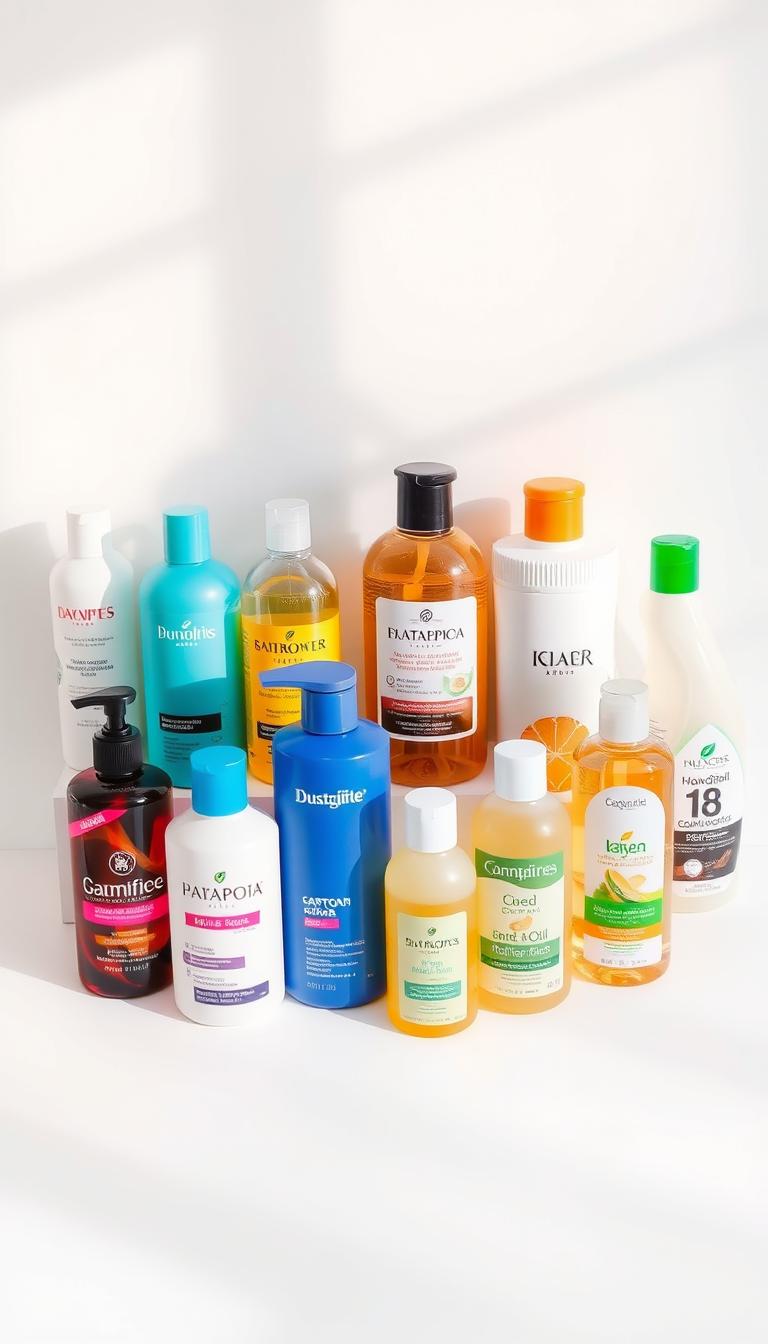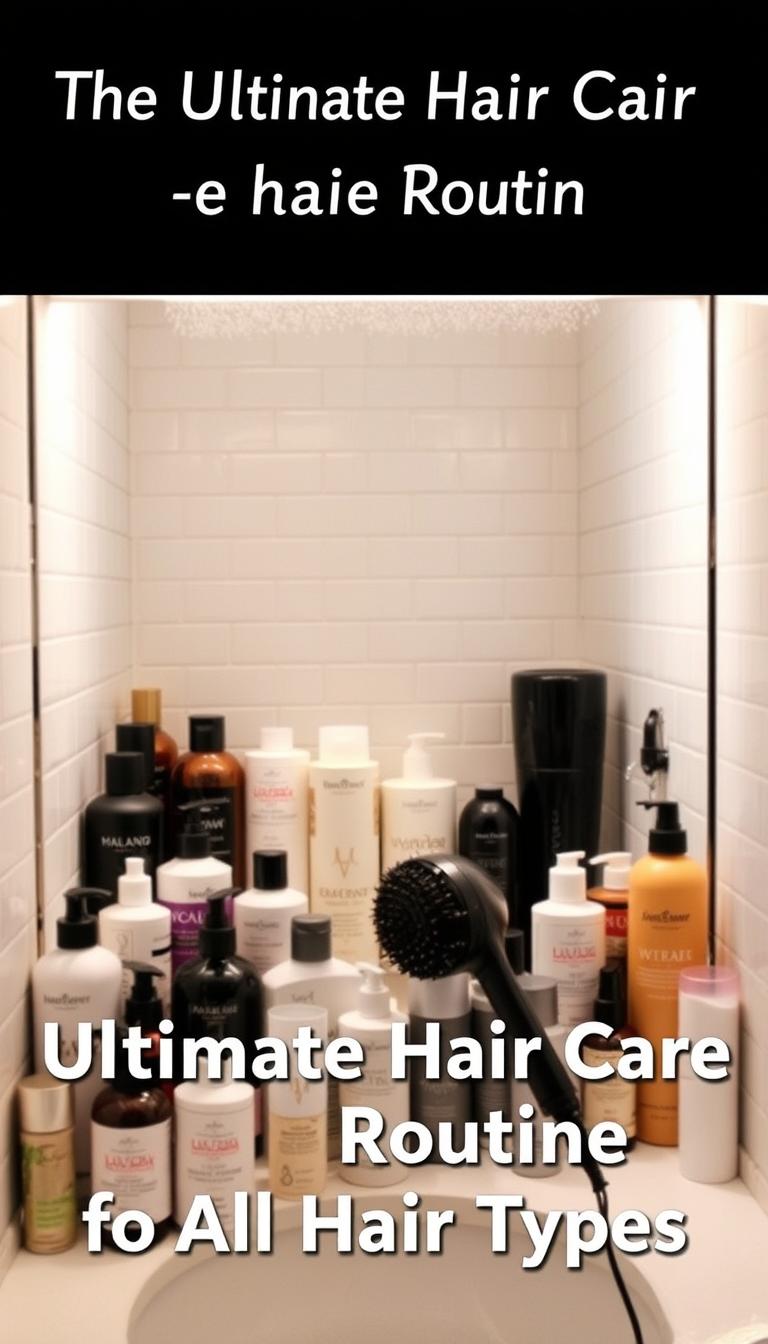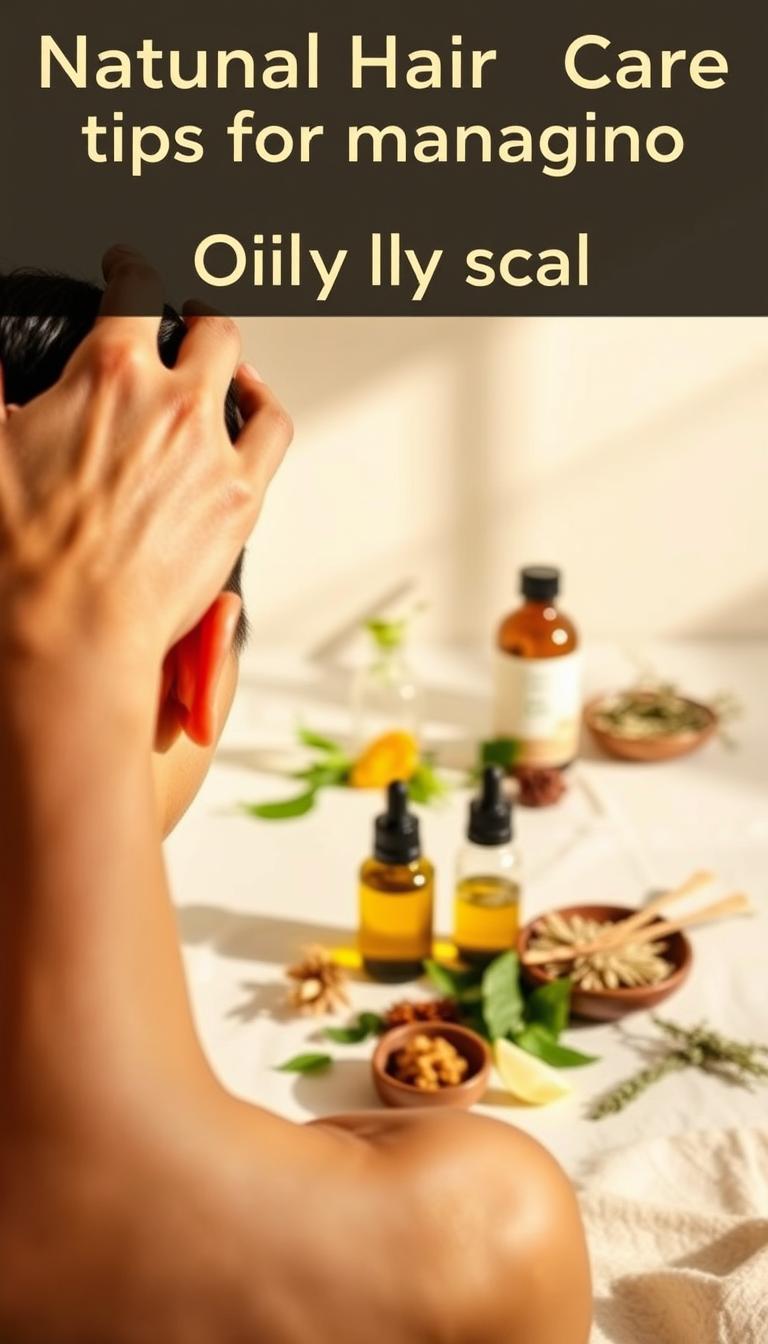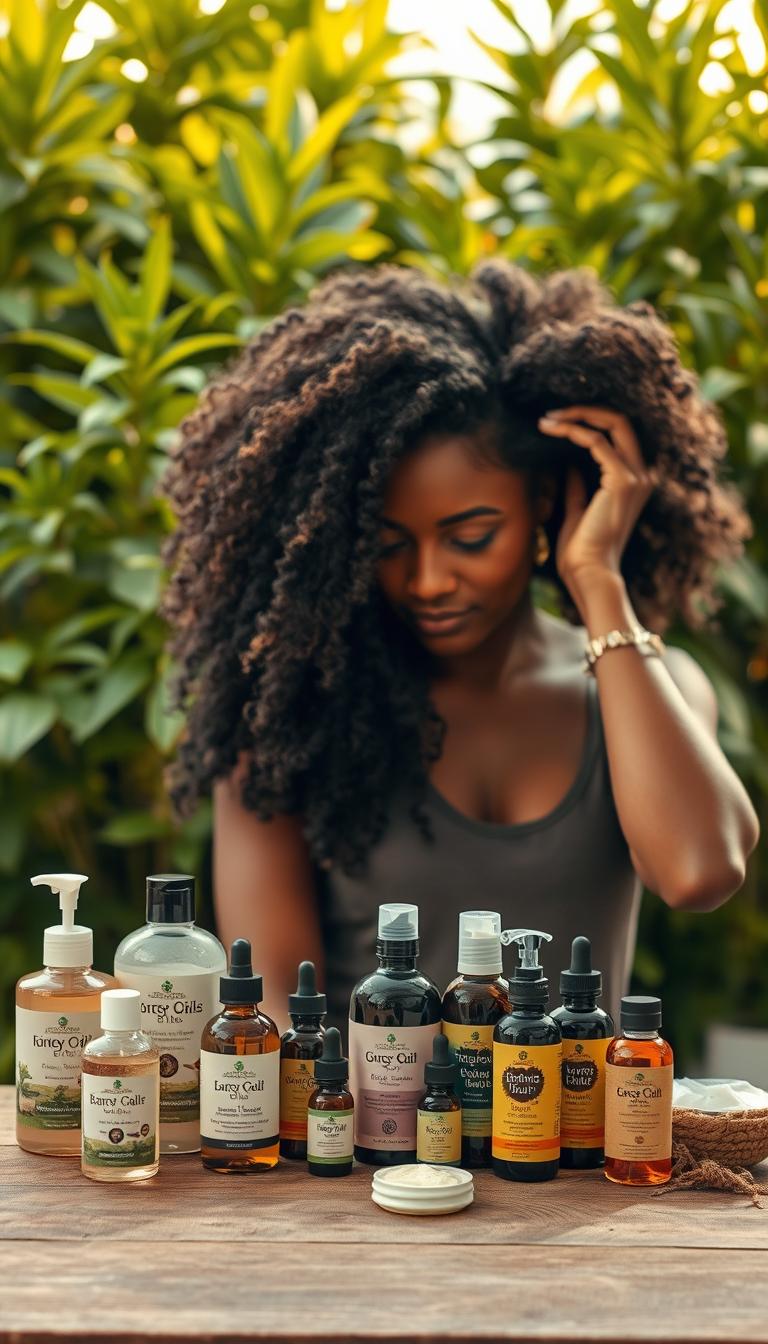Heat Styling Tips: 5 Hair Care Tips for Heat Styling Without Damage
Every day, I face the mirror with my heat styling tools ready. I aim to change my hair into the style I want. But, I worry about the damage heat styling can cause. Heat can harm our hair, making it dry and lifeless.
I’ve seen how too much heat can make hair dull and frizzy. It can even fade the color. That’s why I focus on hair care and using protectants. This way, I can style my hair without harming it.
Key Takeaways
- Understanding the effects of heat damage is crucial for healthy hair maintenance.
- Heat protectants play a vital role in minimizing damage from styling tools.
- Prepping my hair properly can significantly reduce the risk of heat-related issues.
- Choosing the right tools and settings is essential for maintaining hair health.
- Integrating a consistent hair care routine helps promote long-term hair vitality.
Understanding Heat Damage and Its Effects on Hair
Heat damage happens when hair is exposed to high temperatures too often. This strips it of its natural moisture, leading to dryness and brittle hair. Hair is made of keratin, which needs hydrogen bonds to stay strong. When styling tools heat it up too much, these bonds break, harming the hair over time.
What Causes Heat Damage?
Styling tools like hair dryers, flat irons, and curling wands cause heat damage. They are often set too high, over 392°F (200°C). Even temperatures above 140°F (60°C) can damage hair. Frequent blow-drying without protection can make hair split and become weak.
Thermal straightening can also cause hair to overheat. This weakens the hair shaft, leading to serious damage.
Signs of Heat Damage to Look For
I’ve learned to spot several signs of heat damage in my hair. These include:
- Dry and brittle hair, which is prone to snapping.
- Split ends that suggest a breakdown of the hair’s protective layers.
- Dullness, showcasing a lack of natural shine.
- Tangled and frizzy strands due to raised cuticles.
- Reduced elasticity, making my hair less pliable and more susceptible to breakage.
It’s important to understand how severe heat damage can be. It can range from mild dryness to extreme breakage. Using heat protectants regularly can help prevent damage and keep my hair healthy.
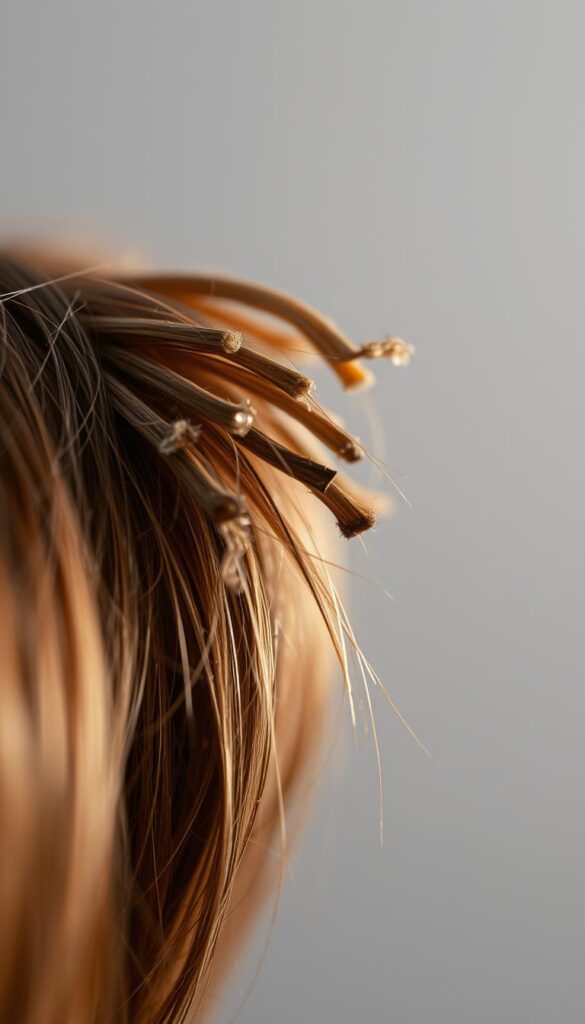
The Importance of Heat Protectants in My Routine
Heat protectants are key to keeping my hair healthy and looking great. They act as a shield against damage from heat styling tools. Finding the right one for my hair type has changed my hair care game.
How Heat Protectants Work
Heat protectants create a protective layer on my hair shaft. This layer seals in moisture and reduces heat damage. They contain ingredients like silicones or polymers to block too much heat.
This is important because hair can get damaged at temperatures over 200°C (390°F). Using heat protectants helps prevent dryness, breakage, and that straw-like hair texture.
Choosing the Right Heat Protectant for My Hair Type
Finding the right heat protectant depends on my hair type. Whether it’s fine, medium, or thick, the right product makes a big difference. I look for ones that reduce frizz and flyaways, keeping my hair shiny and smooth.
It’s crucial to use a heat protectant every time I style my hair with heat. Studies show it can improve hair texture by up to 70%. Knowing the different types helps me choose the best one for my hair, protecting it while I style.
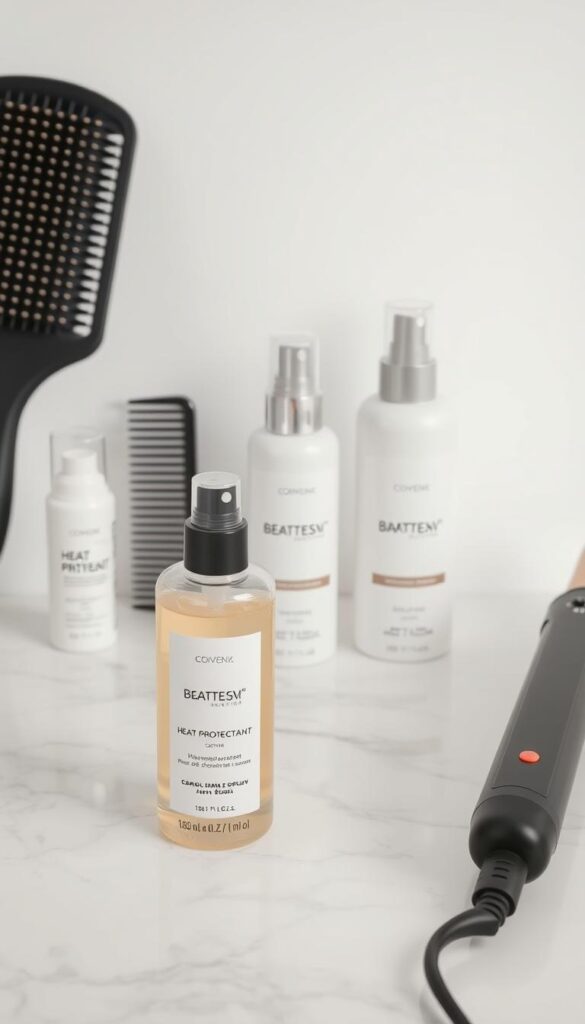
Prepping My Hair Before Heat Styling
Getting my hair ready for heat styling is key. I start in the shower, using top-notch products for hair health. A sulfate-free shampoo removes buildup, letting my styling tools work better.
This step is vital for healthy, vibrant hair.
Washing and Conditioning for Optimal Health
Conditioning my hair after washing is crucial. I pick a conditioner that fights damage and hydrates. Research shows 60% of people use moisturizing shampoos and conditioners to fight humidity.
It’s important to keep my hair moisturized, especially in humid weather. Good washing and conditioning are key to hair health.
The Role of Leave-In Conditioners
After conditioning, I use leave-in conditioners. They add moisture and protection, vital for heat styling. About 80% of hair pros recommend leave-in conditioners for healthy hair.
They help manage frizz, especially at the mid-lengths and ends. Leave-in conditioners also protect my hair from heat damage, which increases in humid conditions.
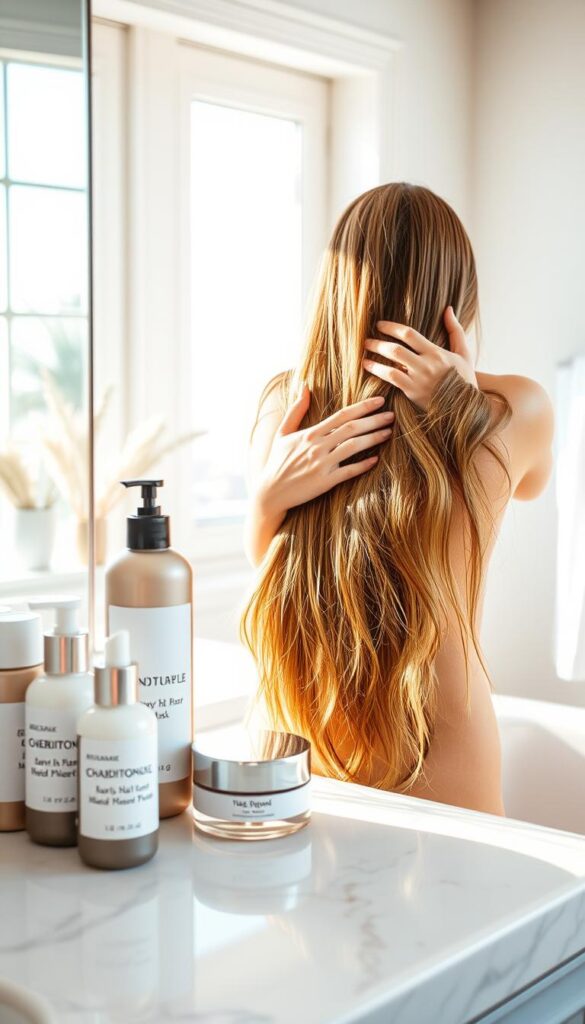
| Category | Benefit |
|---|---|
| Washing Hair | Removes buildup for effective styling |
| Conditioning | Hydrates and strengthens hair |
| Leave-In Conditioners | Provides moisture, protection, and manageability |
By following these steps, I not only get my hair ready for heat styling. I also improve its health and strength.
Best Practices for Using Heat Styling Tools
Using Heat Styling Tools right means knowing the best Temperature Settings and techniques. This helps avoid hair damage. By following best practices, you can keep your hair healthy while getting the style you want.
Setting the Right Temperature for My Hair
Choosing the right temperature is key to avoiding hair damage. For fine or damaged hair, I use a temperature below 300°F (150°C). This helps prevent brittleness and frizz.
Those with thick or coarse hair can usually handle up to 400°F (200°C). Always check the temperature to protect your hair from harmful heat.
The Importance of Sectioning My Hair Properly
Sectioning your hair before styling is crucial for managing frizz and heat. By dividing my hair into small sections, I ensure even heat distribution. This reduces the need for repeated passes, preventing damage.
It also helps me control the styling better, leading to a polished look.
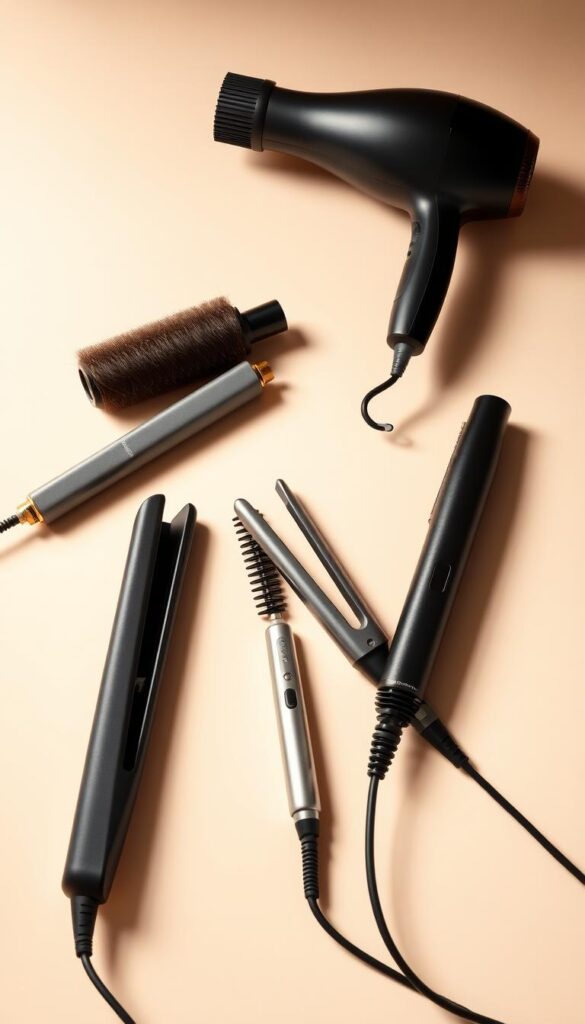
Selecting the Right Tools for My Hair Type
Choosing the right styling tools is key to my hair’s health and look. I can pick between flat irons and curling wands, each with its own perks. Knowing what each tool offers helps me choose the best for my style.
Flat Irons vs. Curling Wands: What’s Best for Me?
Flat irons are great for sleek, straight hair, perfect for daily styling. For most hair types, a 1-inch flat iron works well. Many come with thermal protection to prevent damage.
Curling wands, however, add volume and waves. The barrel size determines the curl tightness. So, I can pick the right size for my curls.
Choosing Between Professional and Drugstore Brands
Professional-grade tools are often more durable and effective than drugstore ones. Brands like FHI Heat or Dyson offer advanced features, including multiple heat settings. This suits different hair types.
While drugstore brands like Shark are affordable, professional tools usually come with longer warranties. This ensures my investment is worth it. Using high-quality tools is crucial for my hair’s health.
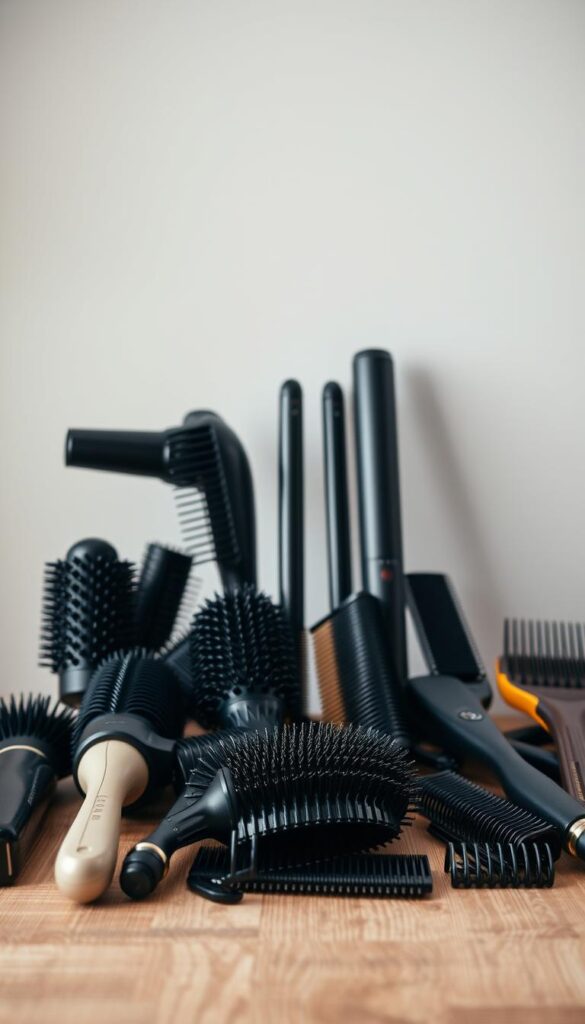
Techniques for Reducing Heat Exposure
Keeping hair healthy with heat styling tools needs careful planning. I start by letting my hair air-dry before styling. Then, I use tools with Lower Heat Settings that match my hair type. These steps help prevent Hair Damage.
Air-Drying Strategies Before Styling
It’s key to let hair air-dry before using heat. I aim for 90% dryness to avoid too much heat. This method cuts down on damage time.
Wet hair is more fragile, so drying it almost completely protects it. This keeps the cuticle layers safe.
Incorporating Styling Tools with Lower Heat Settings
Choosing heat tools with adjustable temperatures is essential. I pick lower settings for my hair, especially for fine or damaged hair. Styling at below 300°F is best for these types.
Thicker hair can handle up to 400°F. But, using the lowest effective temperature is best for Hair Damage Prevention. This avoids dryness, split ends, and brittleness from high heat.
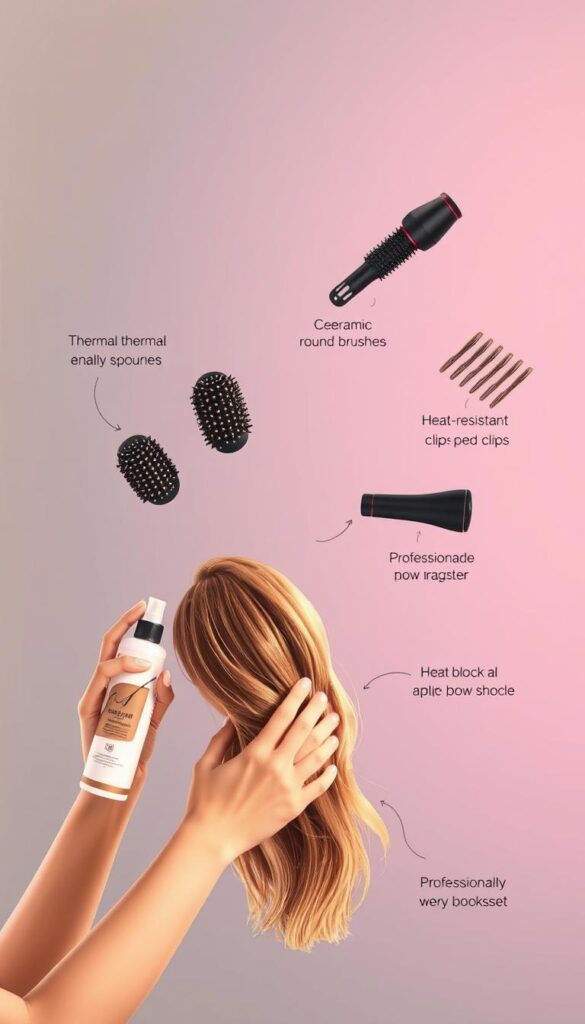
| Hair Type | Recommended Temp (°F) | Heat Tolerance |
|---|---|---|
| Fine/Damaged | Below 300 | Low |
| Thick/Coarse | Up to 400 | Moderate |
| Curly/Coily | Up to 360 | Moderate |
Following these steps makes my hair healthier and styling more enjoyable. It helps me avoid common heat-related problems.
Maintaining My Hair’s Health Post-Styling
After styling my hair with heat, I focus on Post-Styling Care. This is key to keeping it healthy. Hydrating Treatments help fix dry and brittle hair from heat damage. A good care routine after styling helps my hair recover and stay healthy over time.
Hydrating and Nourishing Treatments
I add deep conditioning treatments or hair masks to my weekly routine. These treatments help replace moisture lost during styling. Using them at least once a week is best.
I look for products with peptides and amino acids. They deeply nourish my hair. Quality hair care products are also important for effective nourishment after heat styling.
How Often Should I Wash My Hair After Styling?
I’m careful with how often I wash my hair after styling. I don’t wash it every day. This lets natural oils nourish my hair and keep it hydrated.
Instead, I wash my hair every two to three days, or when it needs it. This helps keep the benefits of treatments and promotes healthy hair. It also helps keep natural shine and prevents dullness from heat styling.

Recognizing When to Take a Break from Heat
Knowing when to stop using heat styling tools is key for my hair’s health. I look for signs that my hair needs a break. If it’s too dry, frizzy, or breaking, it’s stressed and might be damaged.
Spotting these signs helps me start Hair Recovery. This can stop more damage from happening later.
Signs It’s Time to Give My Hair a Rest
- Visible breakage and split ends.
- Frequent frizz and a lack of shine.
- Extreme dryness even after regular conditioning.
- Dull texture that lacks vibrancy.
- Increased tangling, making styling challenging.
Benefits of Heat-Free Styling Alternatives
Using Heat-Free Styling has many benefits for my hair. I can try new ways to style without heat. Braiding, twisting, or using rollers are great options.
These methods help prevent heat damage. They also give my hair time to heal naturally.
Embracing my natural hair texture is liberating. Using products like volumizing mousse and shine serums helps. It makes my hair look better and reduces heat use.
Understanding the right balance between heat styling and care is empowering. It helps me keep my hair beautiful and healthy for years.
Enhancing My Daily Hair Care Routine
Adding effective strategies to my daily hair care routine keeps my hair strong and beautiful. Using moisturizers regularly is key to having hydrated and easy-to-manage hair. Also, taking care of my scalp is crucial for my hair’s health. By focusing on both, I get the best results.
Integrating Moisturizers into My Regimen
My daily hair care routine needs moisture to avoid dryness and bring out shine. I use leave-in conditioners and hair oils to add moisture and nourishment. These products vary in price, but most cost between $21.60 and $64.79.
My chosen moisturizers not only hydrate my hair but also help prevent breakage and improve texture.
The Power of Scalp Care in Overall Hair Health
My hair care routine goes beyond just hair; it also focuses on scalp health. A healthy scalp is essential for preventing dandruff and promoting hair growth. I use nourishing shampoos without harsh chemicals for my scalp treatments.
Nutrients like aloe vera and biotin are vital for my scalp’s health and my hair’s vitality.
Long-Term Strategies for Healthy Hair
Reaching my Long-Term Hair Goals means sticking to a detailed hair care plan. It’s not hard to keep up with a routine that makes my hair healthy and look good. Using gentle, sulfate-free shampoos and conditioners helps keep my hair’s natural oils in.
Eating foods rich in biotin, like eggs and nuts, is key. They help my hair grow strong and break less.
Building a Consistent Hair Care Routine
For Health Maintenance, I make sure to sleep well, aiming for 7 to 8 hours a night. This keeps my hair growth cycle going smoothly. I also try to reduce stress, as it can harm my hair and overall health.
Scalp care is a big part of my routine. Washing with a mild shampoo and using scalp scrubs gets rid of buildup. It helps my hair grow healthier. I also choose hair products that fit my hair type to keep it healthy and looking good.
The Benefits of Regular Trims
Getting Regular Trims every 6 to 8 weeks is crucial to stop split ends. It keeps my hair strong and shiny. As I get older, my hair might get thinner and lose color, so I keep up with my routine.
Genetics and hormonal changes can affect my hair, so sticking to my routine is even more important. With these strategies, my hair can stay healthy for years.
FAQs About Heat Styling and Hair Damage
Heat styling can damage hair if done wrong. Many think higher heat means better results. But, heat over 140°F (60°C) starts to harm hair. Using the lowest heat for my hair type helps avoid damage.
Some believe heat protectants are not needed. But, a study in Polymers shows they’re crucial. Without protectants, hair can split and lose its shape. Knowing this helps me protect my hair and style better.
It’s key to know the truth about hair care. For example, straightening wet hair damages it more. I limit heat styling to once or twice a week. I also focus on keeping my hair hydrated and nourished. This way, I can enjoy styling without harming my hair.
FAQ
What is heat damage, and how does it affect my hair?
How can I minimize heat damage while styling my hair?
What ingredients should I look for in a good heat protectant?
How often should I apply leave-in conditioner?
Is it better to use air-drying techniques before heat styling?
How do I know when to give my hair a break from heat styling?
What role does scalp care play in maintaining healthy hair?
How often should I trim my hair to maintain its health?
What are some common misconceptions about heat styling?
Source Links
- Heat Damaged Hair? Tips to Avoid Heat Styling Damage on Dry Hair
- Mastering Heat Styling: Tips for Healthy, Sleek Hair
- Heat Styling Tips for Different Hair Types
- Complete Guide to Fixing Heat Damaged Hair | Living Proof®️
- How to Protect & Repair Heat Damaged Hair | Live Batiste™
- How To Protect Your Hair From Heat Damage
- Unlock Healthy Hair Growth: The Role of Heat Protectants | Hair Care Essentials
- No title found
- Best Hair Heat Protectants When Using Hot Tools | Be Beautiful India
- How to Prep Your Hair for Heat and Humidity
- Protect + Prime Your Hair For Heat Styling
- The best things you can do to protect your hair when you heat style
- Mastering Heat Styling: Dos and Don’ts for Safe and Stylish Hair
- How to Use Heat Styling Tools Like a Pro
- How To Heat Style With Minimal Hair Damage?
- A Comprehensive Guide: How to Choose the Best Hair Tool
- The Best Heat Tools For Hair: A Complete Guide to Dryers, Irons, & Thermal Brushes – Laura K Collins
- 8 Ways To Prevent Heat-Damaged Hair
- Mastering Heat Styling: Dos and Don’ts for Safe and Stylish Hair
- Complete Guide to Fixing Heat Damaged Hair | Living Proof®️
- 10 Tips to Keep Your Hair Healthy and Avoid Heat Damage
- Complete Guide to Fixing Heat Damaged Hair | Living Proof®️
- How To Heat Style With Minimal Hair Damage?
- Essential Dos and Don’ts of Heat Styling for Healthy Hair
- Complete Guide to Fixing Heat Damaged Hair | Living Proof®️
- 8 Simple Tips You Need to Know to Style Hair Without Heat
- Daily Hair Care Routines: Establishing Consistency for Healthy Hair
- How to Build the Best Hair Care Routine for Your Hair | Software
- Unlock Your Hair’s Potential: 10 Tips for Healthy Hair
- How to Maintain Hair Growth After 50
- How to Care for Fine Hair, According to Stylists
- Complete Guide to Fixing Heat Damaged Hair | Living Proof®️
- Heat Styling Safely: Protecting Your Hair from Damage
- Does Heat Styling Damage Hair?
